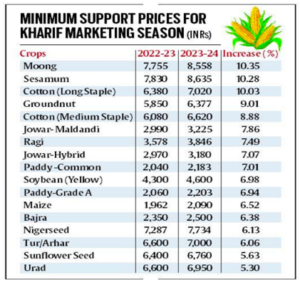Context:
The Centre recently announced a 5.3% to 10.35% hike in Minimum Support Prices (MSP) of all mandated Kharif crops for marketing season 2023-24.

MSP hike vs rate of food inflation and the rise in cost of production:
| Probable Question: Q. Examine the recent MSP hike and its potential impact on various aspects. Highlight the challenges associated with the implementation of MSP and suggest measures to enhance its effectiveness. |

Image Source: The Indian Express
Need for MSP:- Acute lack of warehousing and cold storage in India, a farmer has little bargaining power in the market.
- To serve as a tool in the hands of the policymakers to tweak the production pattern.
- The government incentivises the production of certain crops to ensure that India does not run out of staple food grains.
- MSPs are “support prices” announced by the government (and sometimes state governments add a bonus amount to them) to provide a safety net for farmers.
- By announcing MSPs, the government makes a promise that it will buy (called procurement) from farmers at the announced prices.
- During each cropping season, the government announces minimum support prices for 23 crops.
- Announced by: The Commission for Agricultural Costs & Prices (CACP) recommends MSPs for 22 mandated crops and Fair and Remunerative Price (FRP) for sugarcane.
- CACP is an attached office of the Ministry of Agriculture and Farmers Welfare.
- Crops covered by MSPs include:
-
- 7 types of cereals (paddy, wheat, maize, bajra, jowar, ragi and barley),
- 5 types of pulses (chana, arhar/tur, urad, moong and masur),
- 7 oilseeds (rapeseed-mustard, groundnut, soyabean, sunflower, sesamum, safflower, nigerseed),
- 4 commercial crops (cotton, sugarcane, copra, raw jute)
- The demand and supply of a commodity;
- Its cost of production;
- The market price trends (both domestic and international);
- Inter-crop price parity;
- The terms of trade between agriculture and non-agriculture (that is, the ratio of prices of farm inputs and farm outputs);
- A minimum of 50 per cent as the margin over the cost of production; and
- The likely implications of an MSP on consumers of that product.
- A2: Covers all paid-out costs directly incurred by the farmer in cash and kind on seeds, fertilisers, pesticides, hired labour, leased-in land, fuel, irrigation, etc.
- A2+FL: Includes A2 plus an imputed value of unpaid family labour.
- C2: It is a more comprehensive cost that factors in rentals and interest forgone on owned land and fixed capital assets, on top of A2+FL.
- CACP considers both A2+FL and C2 costs while recommending MSP.
- The government’s procurement of farm produce at Minimum Support Prices (MSPs) is not uniform and varies based on crops and geographical regions.
- Moreover, MSPs currently lack statutory backing, meaning farmers cannot legally demand MSPs as a guaranteed right.
Additional Information:
About Kharif Season:
|
- The prices of cereals went up by almost 14% in April this year. From that perspective, the MSP hike is modest.
- However, the Citi Research note finds that cost of cultivation went up by 6.8% and from that perspective, a 7% hike in MSPs is enough to ensure that farm economy does not lose out to the non-farm economy.
- Inflation and Monetary Policy:
- MSP hike alone is unlikely to directly spike inflation. However, if the normal monsoon is affected by El Nino, it may lead to food inflation.
- Government Finances:
- Higher MSPs involve increased procurement, storage, and disbursal of subsidized food grains, which impose financial burdens on the government.
- According to Citi Research, the recent MSP increase is not expected to materially alter the government’s food subsidy budgeting.
- Impact on Rural India:
-
- The impact on rural India is a crucial aspect of MSP decisions as the rural economy is a significant contributor to India’s overall GDP.
- The recent consumption growth trends in the rural economy have been weak compared to urban areas.
- The 7% MSP increase is considered modest and may just cover the increased production costs, but it may not lead to a significant boost in rural consumption.
- The procurement is concentrated in only a few states — in Punjab, Haryana, western Uttar Pradesh, Chhattisgarh, and Telangana for paddy, in Telangana and Maharashtra for cotton, and in Maharashtra and Karnataka for pulses,” states the CRISIL report.
- MSPs have limited reach, with only rice and wheat being effectively procured.
- Implementation of MSPs is ineffective, with a small percentage of farmers actually benefiting.
- The focus on fulfilling NFSA requirements makes MSPs more of a procurement price.
- The dominance of MSPs for rice and wheat hampers diversification and income growth for farmers.
- Dependence on middlemen adds complexity and hurdles for smaller farmers.
- MSP can incentivize the production of crops important for nutritional security, such as coarse cereals, pulses, and edible oils.
- Focus should also be on investing in animal husbandry, fisheries, fruits, and vegetables, as they offer greater nutritional benefits.
- Private sector involvement and efficient value chains based on a cluster approach can be incentivized.
- Agricultural pricing policy should transition to a combination of state-supported and market-driven pricing.
- A deficiency payments scheme like Madhya Pradesh’s Bhavantar Bhugtan Yojana (BBY) could be considered as a solution.
- Effective implementation of key initiatives such as e-NAM, doubling farmer’s income by 2022, price stabilization fund, and the recommendations of the Swaminathan and Shanta Kumar committees are essential for achieving desired outcomes.
Post Views: 220
